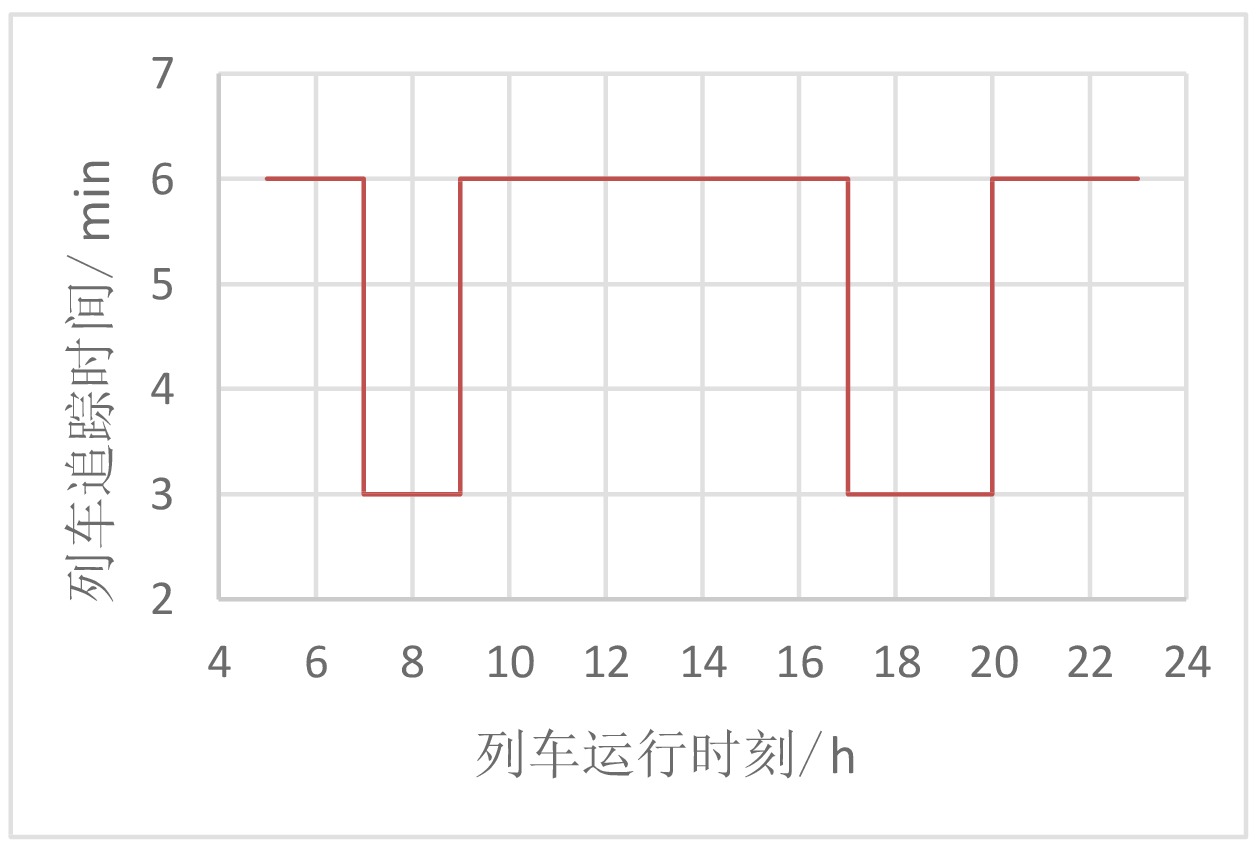One approach to adaptive headway adjustment for train autonomous circumambulation system
-
摘要: 新一代城市轨道交通信号控制系统—列车自主运行系统(TACS,Train Autonomous Circumambulation System)是基于去中心化的“车车通信”思想实现列车自主协同控制的系统,相比传统的基于通信的列车自动控制系统(CBTC,Communication Based Train Control system)更加高效、灵活和经济。为提高城市轨道交通线路运营效率,提出一种用于TACS的列车运行间隔自适应调整方法,在TACS现有技术架构上,增加客流数据分析系统,实时监测整条线路客流量,当线路出现客流高峰时,由列车自动监控系统(ATS,Automatic Train Supervision system)的列车运行调整单元重新生成列车运行时刻表,唤醒休眠列车进入运行状态来增加运力,所有在线运行列车根据最新的列车运行时刻表,交互列车运行信息,自适应调整列车运行时间间隔;通过在客流高峰时段缩短列车运行时间间隔,提高线路载客能力,在客流低峰时段延长列车运行时间间隔,降低线路运营能耗,有效提升线路的运营效率和经济性。该方案原理简单,技术上易于实现,不影响TACS现有结构和性能。
-
关键词:
- 城市轨道交通 /
- 列车自主运行系统(TACS) /
- 列车运行间隔 /
- 自适应调整 /
- 客流数据分析系统
Abstract: The new generation of train control system for urban rail transit-Train Autonomous Circuit System (TACS) is a decentralized train autonomous collaborative control system based on train-train communication. Compared to the traditional communication based Train Control System (CBTCS), it is more efficient, flexible, and economical. To improve the operating efficiency of urban rail transit lines, an adaptive train operation time interval adjustment approach for TACS is proposed. Based on the existing architecture of TACS, a passenger flow data analysis system is proposed to monitor the real-time passenger flow of the entire line. When there is a peak passenger flow on the line, the train operation adjustment unit of the Automatic Train Supervision system (ATS) regenerates the train operation schedule which will trigger the wake-up of dormant trains to enter operating mode to increase carry capacity, and all online running trains exchange train operation data with each other based on the latest train operation schedule, thus adaptively adjusting the train operation time interval. The operational efficiency and economy of the line can be effectively improved by shortening the train operation time interval during peak passenger flow periods to increase the passenger carrying capacity of the line while extending the train operation time interval during low peak passenger flow periods to reduce energy consumption of line operation. This approach has a simple principle and is technically easy to implement, without affecting the existing structure and performance of the TACS . -
我国各大中城市的快速发展增加了通勤距离,对城市轨道交通提出更大的运能需求,城市轨道交通网络的规模和复杂度逐年递增。同时,由难以预测的客流及设备故障给轨道交通网络带来的扰动,使得超强度运营及各种超常规运营成为了常态,要求城市轨道交通具备更灵活的运营能力,如支持潮汐通勤客流对灵活编组、快慢混行的需求,突发客流对任意站穿梭、编队运行的需求,突发故障对任意点折返的需求等[1-2]。
列车自主运行系统(TACS,Train Autonomous Circumambulation System)以去中心化的“车车通信”实现车车的协同控制,减少了因轨旁中转带来的时间损失,提高了线路资源单位时间内利用率,使得列车间追踪间隔更小,显著提升了城市轨道交通运能[3]。文献[4—6]都是基于车车通信思想研制的下一代轨道交通信号控制系统,是城市轨道交通对更高效、更灵活和更经济的列运行车控制系统不懈追求的结果。我国TACS研制开发工作已开展了近十年,目前已进入商用阶段。早在2015年,中车四方所联合青岛地铁启动了TACS研发工作,并于2017年在青岛地铁6号线开展示范应用。2020年3月,文献[7]取得了基于车车通信的列控系统产品认证证书。文献[8]在深圳首条无人驾驶线路—深圳地铁20号线上实现载客运营,成为业内我国首个成功商用的TACS产品。2023年,文献[9]中基于车车通信的TACS列车也成功落地,成为国内首个核心技术全自主化的TACS。
本文提出一种用于TACS的列车运行间隔自适应调整方法,在构建城市轨道交通客流数据分析系统的基础上,实现全线站厅客流量动态监测,由控制中心根据全线路站厅拥挤度情况对运行列车进行调配,自适应地调整客流高峰期与非高峰期的列车运行间隔,使运力与客流量相匹配,提高城市轨道交通的运营效率。
1 TACS简介
TACS是指列车基于运行计划和实时位置实现自主资源管理并进行主动间隔防护的信号系统,通过列车与信号深度融合,将信号、牵引、制动、网络、门控等系统纳入一体化控制平台。
1.1 TACS系统构成
TACS由控制中心、车站设备、车载设备构成。其中,控制中心主要包括列车自动监控系统(ATS,Automatic Train Supervision system)、维护支持系统(MSS,Maintain Support System);车站设备主要包括现地工作站、目标控制器(OC,Object Controller);车载设备主要包括车载控制器(OBC,On Board Control Unit)、对象控制单元(OCU,Object Control Unit)、人机接口(HMI,Human Machine Interface);TACS系统架构如图1所示[10-11]。
(1)控制中心ATS主要负责监视全线路列车运行状态、编制列车运行时刻表等功能,可将预先设置的运行时刻表下发至列车的车载模块,实现对列车的控制;同时,ATS与车站OC及现地工作站协同工作,实现对轨旁资源的合理分配,实现列车的自主进路、自主调整、自主运行等主要功能。
(2)控制中心MSS主要负责监测所有系统设备的工作状态和故障,实现对OC及车载相关设备的监控,下发维护任务,并与控制中心ATS进行实时信息交互。
(3)车站目标控制器OC与现地工作站协同工作,负责轨旁资源状态的实时更新,并实时将状态信息传输至控制中心ATS与车载OBC,确保列车安全运行。
(4)车载控制器OBC集成了列车休眠唤醒模块(AOM,Automatic Operation Module),可根据控制中心ATS传输的运行指令自动控制列车上线运行或下线休眠;列车自动防护(ATP,Automatic Train Protection)负责列车超速防护,保证列车运行安全;HMI提供人机交互界面,展示车辆状态信息;OCU集成列车牵引、制动、网络与信号系统的功能,并简化了这些系统间通信接口,提高列车内部各系统间通信效率。
1.2 列车运行控制基本流程
(1)控制中心ATS预先编制列车运行时刻表,由ATS的列车运行调整单元将列车运行时刻表下发至全线路OC设备及所有TACS列车的车载系统。
(2)TACS列车上线运行后,整条线路上的OC实时监测列车位置、速度等运行信息,并与控制中心ATS、车载OBC进行运行信息的实时交互。
(3)车载OCU自主计算列车到离站时间与列车运行时刻表的偏差,基于自身运行任务和当前位置,主动与所有相邻列车交互信息,并根据交互信息自主更新移动授权(MA,Movement Authority)及控车曲线,计算生成本列车运行调整指令和预计的到离站时间,并将预计的到离站时间发送给ATS的列车运行调整单元,实现列车运行自主调整,增强了列车间隔防护的实时性。
2 线路客流量实时监测
2.1 客流数据分析系统
为提高城市轨道交通运营效率,本文提出建立整条线路的客流数据分析系统,该系统主要包括控制中心客流分析服务器和部署在各车站上的客流数据采集接口设备;并在TACS现有技术架构基础上,增加客流数据分析系统与控制中心ATS的接口,基于客流数据的列车运行间隔调整过程如图2所示。
(1)车站客流数据采集接口设备从车站的视频监控系统、自动售检票系统(AFC,Automatic Fare Collection system)闸机等设备采集实时客流数据,并按固定时间间隔将客流量数据上传给控制中心客流分析服务器;通过在站内候车区域合理布置视频监控系统的摄像头,由车站客流数据采集接口设备利用智能视频分析算法实时统计各站厅内候车的乘客数量;AFC闸机能够实时统计各站进出站客流量;当二者统计的客流量都大幅增大时,表明当前时段进入客流高峰期。
(2)控制中心客流分析服务器接收各车站客流数据采集接口设备上传的实时客流量数据,计算线路上各站站厅客流拥挤度,并据此判断全线客流拥挤度状态,将全线客流拥挤度状态数据传输给中心ATS的列车调整单元。
(3)控制中心ATS的列车调整单元依据客流数据分析系统提供的全线各车站站厅客流拥挤度动态数据,在客流高峰时段重新生成列车运行时刻表,并重新将时刻表传输至车载控制系统,唤醒必要的休眠列车进入运行状态,或在非高峰期使部分列车退出运行状态,从而实现列车运行间隔的自适应调整。
2.2 站厅客流拥挤度
客流数据分析系统根据站内候车乘客统计人数,计算各个车站站厅客流拥挤度。将单位面积内乘客人数定义为站厅客流拥挤度X,即有
X=μ⋅PS (1) 其中,P 为乘客人数,人;S 为乘客可候车面积,m2;
μ 为拥挤度系数,为单位可候车面积所能承载最多乘客人数的倒数,可视车站站厅布局和设备配置情况取不同的数值,如安装有站台屏蔽门的站厅,μ 可以取较小数值。站厅客流拥挤度X∈[0,1],其数值越大,表示站厅越拥挤。基于全天客流统计数据计算站厅客流拥挤度,可生成站厅客流拥挤度曲线。以某地铁站全天运营为例,图3为该地铁站运营期间站厅客流拥挤度曲线。
将站厅客流拥挤度X ≤ 0.5确定为客流通畅,乘客舒适性较好;将X > 0.5确定为客流拥挤,乘客舒适性较差。客流数据分析系统将站厅客流拥挤度转换为站厅客流数字量,即X ≤ 0.5时客流数字量设置为0,X > 0.5时客流数字量设置为1。
3 列车运行时间间隔自适调整
将线路客流数字量
LP 定义为LP=N∑i=1Xi (2) 其中,N为线路车站总数,座;
Xi 为车站i的客流数字量。控制中心ATS设置整条线路客流量阈值
lptv ,如半数以上车站当前客流数字量X为1时,可认为整条线路客流量较大,即lptv=N2 ,当LP ≥lptv 时,认为线路出现客流高峰。ATS列车运行调整单元根据客流数据分析系统实时计算的全线所有车站客流数字量,自动判断整条线路是否出现客流高峰,并据此向运营列车发送指令:唤醒上线、维持运行、列车下线,协同其它所有在线运行列车自适应调整运行时间。
一旦ATS探测到线路出现客流高峰时,会立即唤醒休眠列车进入运行状态来增加运力;同时,由车地无线传输系统将线路客流数字量实时传输至车载系统,所有在线运行列车根据接收的客流数字量信息,通过交互列车运行信息,自适应调整列车运行时间间隔。
以图3站厅客流拥挤度曲线为例,7:00~9:00、17:00~20:00这2个时间段内全线路上站厅客流拥挤度X > 0.5的车站超过半数,表明整条线路站厅客流量较大,列车运行间隔时间缩短为3 min,来增加列车运行频次;其余时间段内站厅乘客拥挤度X > 0.5的车站未超过半数,使列车运行间隔时间恢复为6 min;对应的列车运行时间间隔调整曲线如图4所示。
4 列车运行时间间隔调整效果分析
将列车运行频次和列车载客量的乘积定义为车站运能
σ (人次/h),即有σ=H⋅y (3) 其中,H为列车载客量,人;y为列车运行频次,次/h。在合理范围内,列车运行频次越高,车站运能越大。
站厅乘客拥挤度X与列车运行频次y成正比关系,即有
X∝σ ,或X∝H⋅y 。站厅客流拥挤度X越大,要求列车运行频次y越高。为此,在客流高峰期间,增加列车运行频次y,可充分缓解站厅乘客拥挤程度。以图3站厅客流拥挤度曲线为例,列车运行频次调整前后站厅客流拥挤度变化曲线如图5所示。由图5 可以看出:7:00~9:00、17:00~20:00这2个时间段内,控制中心ATS的列车运行调整单元重新生成列车运行时刻表,运行时间间隔由6 min减少至3 min,将高峰时段站厅客流拥挤度保持在0.5左右;其它时间段客流拥挤度较低,列车按既有运行时刻表运行。
5 结束语
本文提出一种用于城市轨道交通TACS系统的列车自适应运行调整方法,在已有TACS系统列车运行自主调整的技术架构上,通过建设客流数据分析系统及增加该系统与ATS的客流数据接口,利用车站视频监控系统和AFC闸机采集客流数据,实时监测整条线路的客流量,当出现客流高峰时由ATS列车调整单元及时调整列车运行时刻表,唤醒休眠列车进入运行状态来增加运力;所有在线运行列车根据ATS调整生成的最新列车运行时刻表,交互列车运行信息,自适应调整列车运行时间间隔;通过在客流高峰时段缩短列车运行时间间隔,提高线路载客能力,在客流低峰时段延长列车运行时间间隔,降低线路运营能耗,可有效地提升线路运营效率。该方案原理简单,技术上易于实现,仅需增加客流数据分析系统服务器和车站客流数据采集接口设备、调整车站视频监控系统的摄像头布置以及对ATS列车调整单元模块的功能进行扩展,不影响TACS系统现有结构和性能。
如何解决客流数据分析系统中客流数据统计问题、如何配置上线列车数量使线路客流量与线路运能达到最优配置,是目前存在的关键问题。下一步将对上述两类问题做重点研究,进一步完善方案的完整可行性。
-
[1] 王卓然,贾学祥. 我国城市轨道交通信号系统的发展方向[J]. 交通世界,2019(12):158-159. [2] 王潇骁. 城市轨道交通运能提升策略研究[J]. 城市轨道交通研究,2021,24(9):69-72. [3] 向 宫. 列车自主运行系统(TACS)[J]. 智慧中国,2022(5):72-73. [4] 中国国家铁路集团有限公司. 韩国铁道研究院开展列车自动控制系统研究[EB/OL]. [2021-09-30]. https://www.china-railway.com.cn/gjhz/sjtldt/202110/t20211009_117383.html. [5] 林 鸿,王林美,魏艳萍. 关于欧盟Shift2Rail计划的研究[J]. 国外铁道车辆,2019,56(1):11-16. [6] DOCPLAYER. URBALIS Fluence ALSTOM. Enhanced CBTC solution[EB/OL]. [2017]. https://docplayer.net/50149107-Urbalis-fluence-alstom-enhanced-cbtc-solution.html.
[7] 轨道世界. 无感改造再进一步:车车通信列控系统及自主感知运行系统获颁SIL4级证书[EB/OL]. [2021-12-22]. https://t.cj.sina.com.cn/articles/view/1002429827/3bbfdd83019012ush. [8] 卡斯柯信号有限公司. 启骥®TACS—为列车自主运行提供新的解决方案[J]. 城市轨道交通研究,2022,25(11):93. [9] 青岛市情网. 国内地铁首辆最智能TACS系统列车在青亮相[EB/OL]. [2023-04-01]. https://epaper.qingdaonews.com/qdrb/html/2023-04/01/content_18543_7515979.htm. [10] 罗情平,吴 昊,陈丽君. 基于车−车通信的列车自主运行系统研究[J]. 城市轨道交通研究,2018,21(7):46-49. DOI: 10.16037/j.1007-869x.2018.07.012 [11] 陈尔超. 车车通信在轨道交通信号改造中的应用研究[J]. 交通科技与管理,2022(7):17-19. -
期刊类型引用(1)
1. 林遵虎,蔡秉江,薛松,黄礼春,杨雁彬. 一种智能化的枢纽站轨道交通换乘线路调度方法. 电子设计工程. 2024(24): 167-170+175 .  百度学术
百度学术
其他类型引用(0)





 下载:
下载:


















